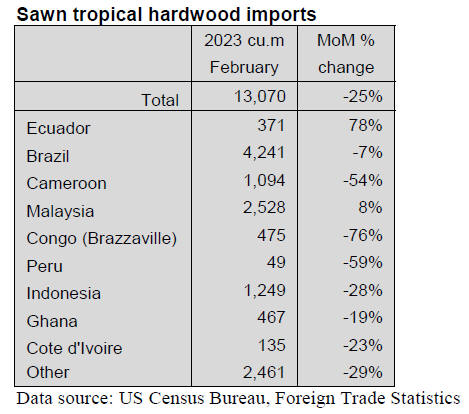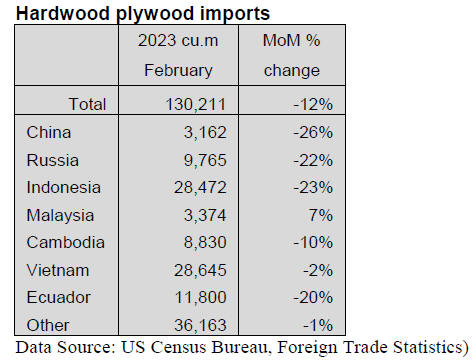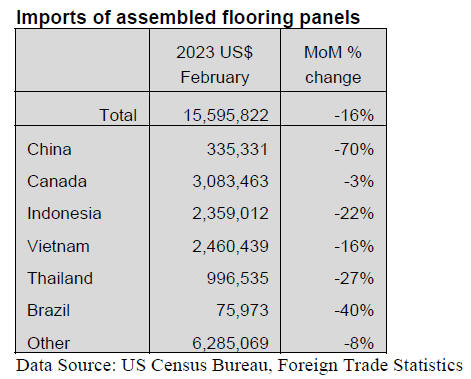|
Report from
North America
Imports continue trending downward
US imports of tropical hardwood products remained on a
downward path in February. Imports of hardwood
plywood fell to their lowest volume in 14 years while
sawn tropical hardwood imports tumbled 25% and imports
of wooden furniture fell 19%. Imports in the sector have
been tracking steadily downward since autumn of 2022.
Sawn tropical hardwood imports fall for fifth month
US imports of sawn tropical hardwood fell sharply in
February, declining for a fifth consecutive month. The
13,070 cubic metres imported in February was 25% less
than in January and was 44% less than that of the previous
February.
Imports from all countries are lagging, most notably
imports from Indonesia (down 28% for the month and
73% for the year so far), Cameroon (down 54% for the
month and 39% for the year so far) and Brazil (down 7%
and 37%).
Imports of Sapelli fell for the fifth time in six months,
dropping 66% in February to a level 57% lower than
February 2022, while imports of ipe, acajou d’Afrique,
and meranti all declined significantly. Imports of keruing
rose 20% in February but were still 4% lower than the
previous February. Total imports trail those of last year by
38% after the first two months.
Canada’s imports of sawn tropical hardwood grew in
February, rising 20% from the previous month. Rising
imports from Brazil, Malaysia, and Cameroon fueled the
gain. Total imports are up 5% over last year through the
first two months of the year.

Hardwood plywood imports down 63%
US imports of hardwood plywood continued to plummet
in February. Imports fell 12% for the month to a level 63%
below that of the previous February. The 130,211 cubic
metres imported in February was the lowest monthly
amount imported since March 2009.
Imports from China, Russia and Indonesia all fell more
than 20% and were down well over 50% for the year so
far.
Imports from Ecuador also fell 20% in February but were
up 28% for the year so far. With the exception of
Ecuador, imports from all major trading partners were
down sharply over the first two months of the year as total
imports are off by nearly two thirds.

Veneer imports up 64% over a year ago
While US imports of tropical hardwood veneer fell 17%
by value from the previous month, the February total was
64% above that of February 2022. As imports typically
decline in February, the decline of only 17% can be seen
as a positive sign, as can a significant increase in imports
from Italy in February after an anemic January number.
While year-to-date imports from Italy are still down 46%
through the first two months of the year, total imports are
up 26% overall while imports from Ghana, Cote d’Ivoire,
and Cameroon have more than doubled.
Hardwood flooring imports dip
The value of US imports of hardwood flooring fell back in
February, falling 7% after two months of growth. Imports
from China fell 61% in February while imports from
Brazil fell 41% and imports from Malaysia fell 37%.
Imports from Indonesia, which have fueled most of the
uptick in imports over the last few months fell 19% but
remained more than double what they were a year ago.
Total imports of hardwood flooring were up 12% through
the first two months of the year chiefly due to the strength
of imports from Indonesia.
Imports of assembled flooring panels fell for a fifth
straight month in February, declining 16%. Import figures
remain weak across the board. Imports from China fell
70% for the month and are down 69% year to date.
Imports from Thailand were down 27% in February and
are 86% behind last year to date and imports from
Indonesia fell 22% in February and are off 26% year to
date. Total imports of assembled flooring panels are down
46% versus last year through the first two months of the
year.

Moulding imports down again
The value of US imports of hardwood moulding fell
another 11% in February, declining for the fifth
consecutive month. Gains in imports from Brazil and
China were more than offset by declines from most other
trading partners including Malaysia, which fell by 12%
and a 4% dip in imports from Canada.
Despite the February gain, imports from China are off by
52% so far this year. Total imports of hardwood moulding
are down 21% versus last year through the first two
months of the year.
Wooden furniture imports tumble
US imports of wooden furniture tumbled 19% in February,
dropping below the US$1.5 billion mark for the first time
since June 2020. The US$1.46 billion in February imports
is 24% below that of February 2022.
Imports were down consistently among lead suppliers:
imports fell between 20% and 25% from China, Vietnam,
Malaysia, Indonesia, and India. Imports from Mexico
were down only 6% while imports from Canada rose less
than 1%. Total imports of wooden furniture are down
20% through the first two months of the year.
As for the overall furniture market, the latest Smith
Leonard survey of residential furniture manufacturers and
distributors showed new orders in January 2023 were up
5% from December 2022, but fell 25% from January 2022.
Smith Leonard noted that the results for January 2023
pretty much show what most described as a “slowing” of
business for early part of 2023. Approximately 77% of the
participants reported negative growth in orders compared
to January 2022.

US cabinet sales rise
According to the Kitchen Cabinet Manufacturer’s
Association's monthly Trend of Business Survey,
participating cabinet manufacturers reported an increase in
overall cabinet sales of 12.8% for February 2023
compared to the same month in 2022.
Custom and semi-custom cabinet sales increased year over
year as well. Custom sales, year over year, were up more
than 27% and semi-custom sales were up more than 21%.
Stock sales, however, were down 22%.
See:
https://kcma.org/insights/february-trend-businessreport#:~:text=According%20to%20the%20KCMA's%20monthly,the%20same%20month%20in%202022.
US extends duty evasion probe into plywood from
Vietnam
The US Department of Commerce (DOC) recently
unveiled an extension of the deadline for issuing its final
conclusion on a trade remedy duty evasion probe into
hardwood plywood imported from the Vietnamese market.
This marks the sixth time that the DOC has announced an
extension, with the final determination expected on 2 May.
In July 2022, the DOC announced the preliminary
conclusion of the case, saying that plywood from Vietnam
using materials from China should be subject to the same
anti-dumping and anti-subsidy duties applied to the
northern neighbour.
If the materials are produced in Vietnam or other countries
the products will be exempt from any duties. The
provisional tax rate may be up to 378.26%, applicable to
shipments imported into the US from June 17, 2020.
However, the DOC has allowed Vietnamese enterprises to
cooperate in the investigation process in order to selfcertify
that they do not use Chinese materials. The number
of enterprises participating in the self-certification
accounted for about 80% of Vietnamese exports during the
investigation period.
Currently, the US applies an anti-dumping duty of
183.36% and an anti-subsidy tax ranging from 22.98% to
194.90% on the product from China.
Statistics compiled by the US Customs and Border
Protection indicate that exports of plywood using
Vietnamese hardwood materials to the US continuously
increased from US$112.3 million in 2018 to US$226.4
million in 2019, US$248.5 million in 2020, and US$356.7
million in 2021.
See:https://english.vov.vn/en/economy/us-extends-duty-evasionprobe-into-plywood-from-vietnam-for-sixth-timepost1009981.vov
Manufacturing sector still shrinking
Economic activity in the manufacturing sector contracted
in February for the fourth consecutive month following a
28-month period of growth say the nation's supply
executives in the latest Manufacturing ISM Report On
Business.
The ISM's manufacturing PMI edged up to 47.7 last month
from 47.4 in January. The small rise was the first in six
months. Any level below 50 denotes contraction in the
sector.
Only four industries, including transportation equipment
and electrical equipment, appliances and components,
reported growth last month. Paper products, textile mills,
furniture and related products were among the 14
reporting sectors contraction.
But the worst could be over for manufacturing. So-called
hard data on factory production was solid in January,
while business spending on equipment appeared to have
rebounded at the start of the first quarter. Comments from
some manufacturers in the ISM survey were supportive of
this thesis.
See:https://www.ismworld.org/supply-management-news-andreports/reports/ism-report-on-business/pmi/august/

|